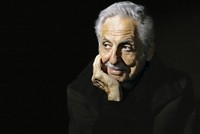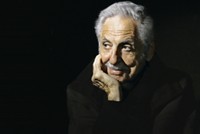Advertisement
Grab your lab coat. Let's get started
Welcome!
Welcome!
Create an account below to get 6 C&EN articles per month, receive newsletters and more - all free.
It seems this is your first time logging in online. Please enter the following information to continue.
As an ACS member you automatically get access to this site. All we need is few more details to create your reading experience.
Not you? Sign in with a different account.
Not you? Sign in with a different account.
ERROR 1
ERROR 1
ERROR 2
ERROR 2
ERROR 2
ERROR 2
ERROR 2
Password and Confirm password must match.
If you have an ACS member number, please enter it here so we can link this account to your membership. (optional)
ERROR 2
ACS values your privacy. By submitting your information, you are gaining access to C&EN and subscribing to our weekly newsletter. We use the information you provide to make your reading experience better, and we will never sell your data to third party members.
Policy
Movers And Shakers
Self-Exploration By An Intellectual Polygamist
Carl Djerassi searches to understand the drivers behind his serially redefined life
by Jeffrey I. Seeman
October 20, 2014
| A version of this story appeared in
Volume 92, Issue 42

Life finally has caught up with Carl Djerassi.
One wouldn’t know it, by the density of his travel, lecture, and writing schedules. But at almost 91, Djerassi knows that each word may well be his last. After several autobiographies and numerous other writings, the publication of “In Retrospect: From the Pill to the Pen” surely will meet the promise of his earlier published volume in German (2013), “Die allerletzte Autobiografie” (“The Very Last Autobiography”), somewhat revised, retitled, and now published in English.
Whatever the title and language, this is a book rich in content and worthy of deep reflection.
And if there is anyone who deserves to have had several autobiographies published and read, it is this superhuman character whose longevity, intensity, intellectual polygamy, insatiable curiosity, and 24/7 lifestyle have provided him the equivalent of multiple lives.
Why read this autobiography? One might want to look inside a rare mind. Or be curious as to how the elite of our community experience life. Or be fascinated by the motivations and demons of the seemingly ultra-successful. Djerassi has accumulated an astounding combination of life’s affairs. To follow Djerassi as he searches to understand himself and to be revered is far more than entertainment. Finally, this work focuses almost entirely on the past 25 years of Djerassi’s life, which are not recorded in his earlier autobiographies.
Djerassi’s brutal honesty, shocking and provoking as it frequently is, provides him permission, if not encouragement, to explore topics that normally are not discussed in open company but nonetheless are both relevant and revealing: sex and contraception and conception, suicide, interpersonal conflict, revenge, loneliness, obsessive behaviors, deep personal bitterness, prejudice and anti-Semitism.

“In Retrospect” is hardly an autobiography, if autobiography is meant to mean “a written account of the life of a person written by that person.” Djerassi does know how to write an autobiography. His first, “Steroids Made It Possible” (SMIP), published in 1990 by ACS Books and edited by this reviewer, began “How did I get into chemistry?” and proceeded chronologically almost to the point in 1992 where he closed his Stanford University laboratories. The pages are filled with chemical pictography, fitting for a volume written about chemistry for chemists and not for a broad audience. “In Retrospect” is another animal altogether, reflecting Djerassi’s post-1992 foci and addressed to a broad readership.
“In Retrospect” contains 10 chapters, each of which can be read as a stand-alone essay on a clearly designated topic (e.g., “Suicide,” “ ‘Jew,’ ” “Professor of Professional Deformation,” “Collector”). Some include well-identified excerpts from his previously published books and plays. He clearly anticipates that he will be criticized for self-plagiarism, in one instance even describing an excerpt as “a case of borderline-legitimate triple self-plagiarism.” To the question, “Why try to rewrite partially in your autobiography what you’ve already painfully and optimally composed in your earlier writings?” Djerassi reasonably concludes that most of the present public has not read his earlier works, and this may be the last chance for these words to be read.
Djerassi presents his reasons for writing this book in Chapter 1, “Caveat Lector”—“Let the reader beware.” He describes his postchemistry life and reinterprets earlier published self-reflections, primarily through autopsychoanalysis. He is proud of his “methods of overcoming grief and disaster” through incessant workaholism and much travel.
Chapter 2, “Suicide,” opens with an Oct. 30, 2023, news report of his own suspected suicide, pretending to discover what other people think of him by reading his own obituary. This gallows humor reveals Djerassi’s preoccupation with suicide, a topic he faced too often in his life, including his own daughter’s suicide nearly 40 years ago. The latter is explored more fully in a subsequent chapter.
Chapter 3, “The Bitter-Sweet Pill,” covers the chemical birth of the Pill because he assumes that many nonchemical readers “are ill-informed.” But the truly innovative part is his discussion of the future: “the divorce of coitus from reproduction” and the reasons why he believes we shall never have a Pill for men. And yet he ends with a proposal contradicting his own prediction.
Djerassi’s lifelong “Search for a Home (Heimat)” and his many deeply sad disappointments are described in Chapter 4, “Heimat(losigkeit),” and also in C&EN’s cover story honoring Djerassi’s 90th birthday (Oct. 21, 2013, page 10). In addition to his expulsion from his home in Nazi Vienna, Djerassi records some deeply felt traumatic rejections from two other places that should have been Heimats, Stanford’s chemistry department and London. He felt deeply hurt by the lack of respect from some of his Stanford colleagues. And after the premature death of the love of his life, his third and much younger wife, Diane Middlebrook, Djerassi discovered that their London friends were, in fact, mostly Diane’s friends. Their London home and life was like a “Potemkin village, artificial, nothing behind it.”
In subsequent chapters, Djerassi explores the meaning of being socially, culturally, and intellectually Jewish versus religiously Jewish.
He reviews his efforts to teach chemistry differently and also to bridge science with the humanities and social sciences. He is proud of his pedagogical experiments at Stanford, and pedagogy was quite deliberately Djerassi’s gateway from chemical research to his writing activities. He applies his intimate knowledge of practicing science to his writings. Djerassi also attributes this transformation to his disillusionment with the American chemical community, which had not recognized his academic (compared to his industrial) achievements to the extent he felt warranted. In addition, just at that time he imagined that his writing would provide a measure of revenge on Middlebrook (a noted author, poet, and academic herself), who had broken up with him more than one year earlier. Having learned that her new paramour was a member of the literati, Djerassi wanted to prove his worth and demonstrate to Diane that he could also write beyond pure science. In the end, they reconciled and married, and he turned into a full-time author.
In Chapter 8, “Collector,” Djerassi muses on his lifelong obsession with collecting. He collected in phases: first pre-Columbian art, then paintings and sculptures of many artists, especially Paul Klee, because Djerassi was attracted to paintings displaying “inherent sarcasm; bizarre portrayals of the human figure; even their frequent perversity coupled with his talents as musician, poet and pedagogue.” He amassed one of the largest Klee collections in the world.
The suicide of his daughter, Pamela, at age 28 caused Djerassi to rethink his relationship to art and collecting. Pamela was an artist, and Djerassi wanted to do something special in her honor by supporting living artists. He formed the Djerassi Resident Artists Program (DRAP) near San Francisco with the mission “to support and enhance the creativity of artists by providing uninterrupted time for work, reflection, and collegial interaction in a setting of great natural beauty, and to preserve the land on which the Program is situated.” He sold most of his art to fund DRAP and gave 600 acres of his ranch to the program, which has become one of the best known artists’ colonies in the U.S. In essence, Djerassi transformed himself, from a collector to a donor to a major philanthropist.
Chapter 9, “What If?” responds to the questions, “What would I now do differently if I could live my life all over again?” and “Was there anything I could have done to prevent the greatest tragedy of my life, the suicide of my daughter?” Djerassi recounts in detail the disappearance of his daughter, the terror that he might not find her body, his suffering, and then his commitment to make something for the living out of her death. “My dearest Pamela. How I wish that your death had not been necessary before I took seriously the patronage of the living.”
Yet I am left wondering: What would he have done differently? Was there anything he could have done to prevent Pamela’s suicide? We are not told what, in his mind, those alternatives might have been. What we do see is Djerassi’s omnipresent state of restlessness.
Djerassi’s life does model after his heroes, “polymaths like Leonardo da Vinci or Dr. Samuel Johnson, who were never content to stay within the boundaries of any single art or profession.” Djerassi’s curmudgeonly ingenuousness comes through in his lifelong exploration of new territories that seem unrelated or tangential to casual observation. Yet, in reality, these activities—the Pill and associated drug development, chemical research, his search for his Jewish identity, his writings, his collections, his philanthropy—were all opportunities to excel in fields that are only seemingly dissimilar to his original field of expertise, organic chemistry with its logic, experimentation, and opportunities for didacticism.
As Djerassi makes clear in “In Retrospect,” serious wounds fester over his not having a Heimat. His acrimony and anger have lasted for decades: being expelled from his home country; being considered by his peers as an industrial, not an academic, chemist; being ignored by some of his Stanford colleagues; and becoming aware of rejection by many of his late wife’s friends in London.
In the decades after fleeing Europe, Djerassi wanted to be unique and apart from his colleagues and, at the same time, he wanted to belong. When at Syntex, he wanted to be known for his scholarship. When retiring from Stanford and giving up his chemistry for writing, he still wanted to be a welcome part of that academic community. When in London, he wanted to be accepted for himself but was, in reality, relegated to being the consort of his famous wife. Again and again, he transformed himself yet wanted to be respected as much for his new self as for what he had been. And now, he has chosen to live mostly in Vienna, the city of his youth and original expulsion, where he is experiencing welcome and reconciliation. But, he asks, to what extent is this due to feelings of guilt by the Austrians?
Perhaps uncertainty is the ultimate fate of productive insecurity—a term Djerassi invented and the foundation of the life he has lived.
Jeffrey Seeman, a Ph.D. chemist, is a visiting senior research scholar at the University of Richmond and an avid student of the history of chemistry.





Join the conversation
Contact the reporter
Submit a Letter to the Editor for publication
Engage with us on Twitter